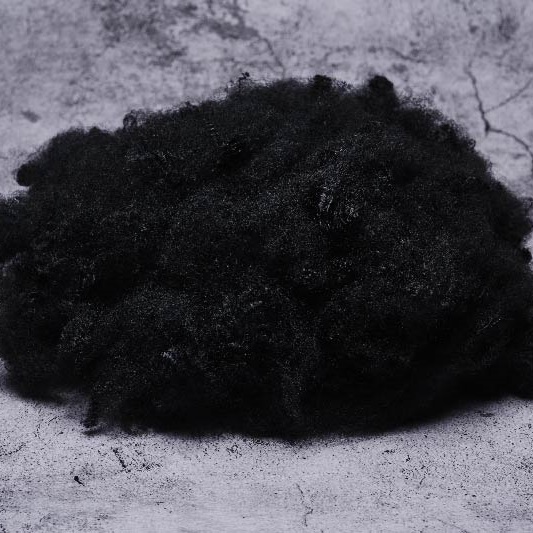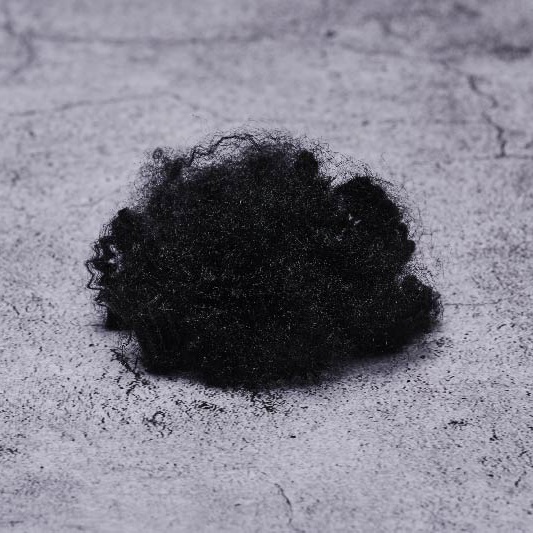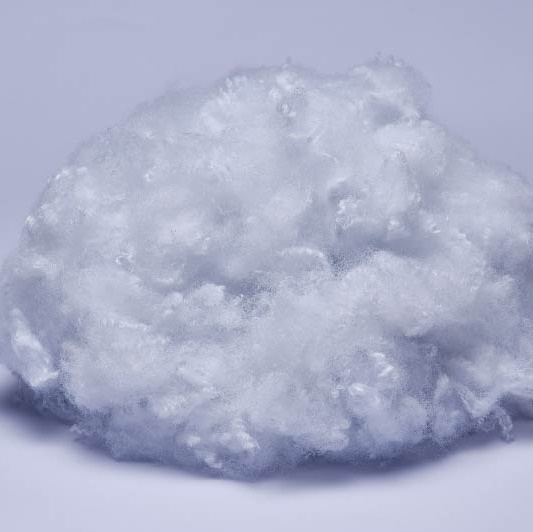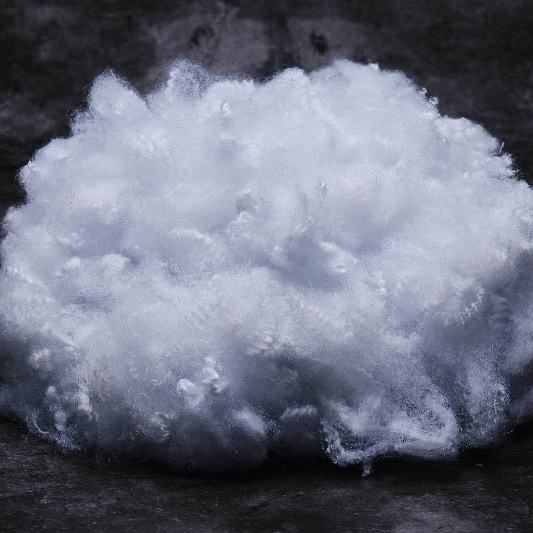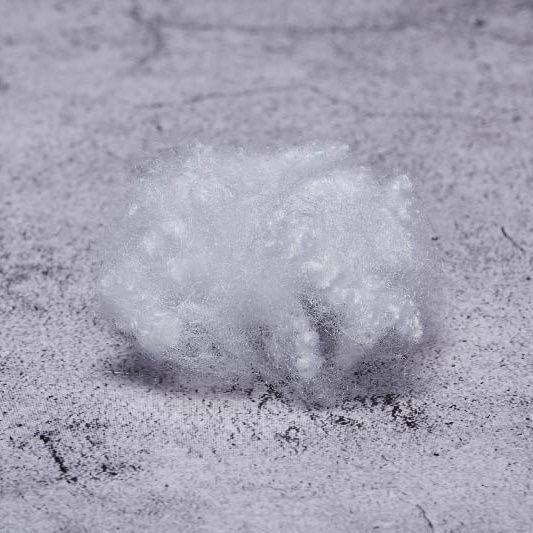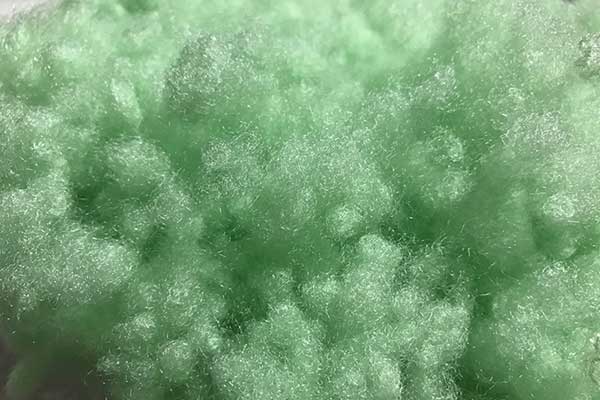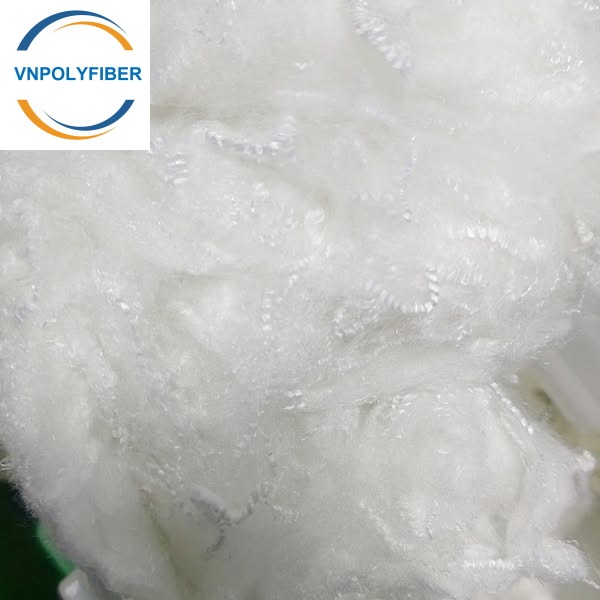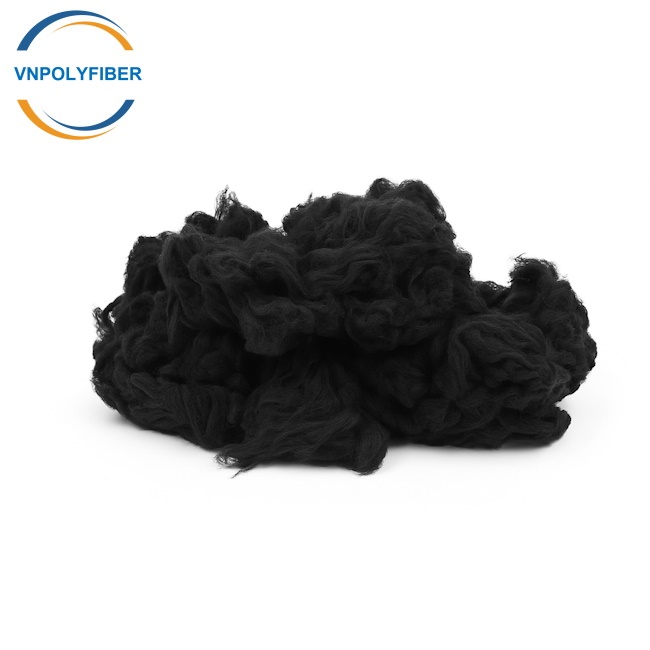Three-Dimensional and Two-Dimensional Structure of Polyester Staple Fiber
- The main difference between two-dimensional and three-dimensional polyester fibers lies in their structure and properties.
- Two-dimensional polyester fibers have a flat, ribbon-like shape and are used in a wide range of textile applications, while three-dimensional polyester fibers have a bulkier, loftier structure and are often employed for their enhanced insulation or cushioning properties.
PRODUCT DETAIL
The Need for Synthetics: Why Move Beyond Natural Down?
Among the most promising advancements are specialized polyester fibers engineered with unique structures to maximize thermal efficiency, comfort, and versatility. Two standout examples are three-dimensional (3D) imitation down fiber and two-dimensional (2D) hollow polyester staple fiber. These aren’t just simple polyester strands; they represent clever material science, harnessing physics and specialized manufacturing to create high-performance materials for a vast range of applications.
Before exploring the specifics of 3D and 2D fibers, it’s worth understanding the driving forces behind synthetic insulation development:
- Performance in Wet Conditions: Natural down clumps when wet, losing its loft (the fluffiness that traps air) and therefore its insulating properties. Synthetic fibers, typically hydrophobic (water-repelling), maintain significantly more warmth even when damp.
- Ethical Considerations: Concerns about animal welfare, specifically live-plucking or conditions in down sourcing, have led many consumers and brands to seek cruelty-free alternatives.
- Hypoallergenic Properties: Natural down can trigger allergies in some individuals. Synthetic fills are generally hypoallergenic, making them suitable for a wider audience.
- Cost and Availability: Down prices can fluctuate, and high-quality down is expensive. Synthetics often offer a more cost-effective and stable solution.
- Ease of Care: Synthetic insulation is typically easier to wash and dry than natural down, requiring less specialized care.
These factors created a fertile ground for innovation, leading to fibers engineered for specific performance characteristics.
Deep Dive: 3D Imitation Down Fiber – Engineering Loft and Warmth
The term “three-dimensional and imitation down fiber” points directly to its core function and structure. This fiber is engineered to replicate the complex, lofty structure of natural down clusters.
Natural down works because its intricate, three-dimensional clusters create countless tiny air pockets. These pockets trap body heat, preventing it from escaping, while also being incredibly lightweight. 3D imitation down fiber aims to achieve this through:
- Complex Fiber Geometry: Unlike simple, straight fibers, these synthetic filaments often have engineered crimps, spirals, or waves in multiple dimensions. When processed into batting or fill, these fibers don’t lie flat; they interlock and push against each other, creating and maintaining a voluminous, “fluffy” structure.
- Air Trapping: This engineered loft is crucial. The spaces created between the tangled, multi-dimensional fibers form a stable matrix of trapped air. Air is an excellent insulator, and maximizing the volume of trapped, still air relative to the fiber weight is key to thermal efficiency.
- Resilience: The 3D structure often gives the fiber assembly good compression resistance and recovery (bounce-back). This means it can be compressed (like in a stuff sack) and regain its loft and insulating properties afterward, although perhaps not always to the same degree as high-quality down over many cycles.
Key Properties and Benefits:
- Exceptional Warmth: By effectively mimicking down’s air-trapping ability, 3D fibers offer high levels of insulation, suitable for cold-weather apparel and gear.
- Lightweight: While perhaps not always matching the absolute lightest, highest-fill-power down, premium 3D synthetics offer excellent warmth for their weight, crucial for performance gear and comfortable bedding.
- Softness and Comfort: The fine denier (thickness) of the fibers combined with the fluffy structure results in a soft, pliable material that drapes well and feels comfortable against the skin or within a garment/bedding item.
- Breathability: Despite trapping heat effectively, the structure typically allows moisture vapor (sweat) to pass through, preventing a clammy feeling. This is vital for activewear and sleep comfort.
- Hydrophobicity: As a polyester-based material, it naturally resists absorbing water, maintaining insulation better in damp conditions than down.
- Durability and Washability: Generally robust and able to withstand machine washing and drying cycles with appropriate care.
- Hypoallergenic: Free from the potential allergens associated with bird feathers.
Applications:
The high performance profile of 3D imitation down makes it ideal for:
- Apparel: Insulated jackets, vests, pants, and snowsuits where warmth, low weight, and moisture resistance are paramount.
- Bedding: Duvets, comforters, pillows, and mattress toppers, offering a warm, soft, hypoallergenic alternative to down.
- Outdoor Gear: Sleeping bags, insulated camping mats, and booties, where performance in potentially damp conditions is critical.
- Upholstery and Furnishings: Used as fill in cushions and furniture for comfort and loft.
Exploring 2D Hollow Polyester Staple Fiber – Simplicity Meets Efficiency
While 3D fibers focus on complex spatial arrangements, the innovation in two-dimensional hollow polyester staple fiber lies within the individual fiber itself and its collective behavior.
The Science Behind the Structure:
- Hollow Core (“Cavity”): This is the defining feature. The “profiled fibers” are extruded through a “specially engineered spinneret” designed to create a continuous void or channel running down the center of each fiber, much like a tiny drinking straw.
- Enhanced Insulation: This hollow space traps air within the fiber itself, adding another layer of insulation beyond the air trapped between fibers.
- Reduced Weight: Replacing solid core material with air naturally makes the fiber lighter for a given diameter or volume.
- Free-Convection: The description mentions “free-convection air movement” within the cavity. While convection typically involves bulk fluid movement (which is minimal in such tiny confined spaces), the trapped air significantly reduces heat transfer via conduction through the fiber material itself. The primary mechanism is still trapping still air, both within and between fibers.
- Two-Dimensional Crimp (“Wavy Pattern”): Unlike the complex 3D structure, these fibers are described as curling in a “wavy pattern.” This crimp is primarily in two dimensions (like a wave on a string).
- Bulk and Loft: The crimp prevents the fibers from packing tightly together, creating space between them for – again – trapping air. This contributes significantly to the overall insulating power and gives the filling material bulk.
- Softness and Elasticity: The crimp acts like tiny springs, giving the fiber mass resilience (the ability to bounce back after compression) and contributing to a softer, more pliable feel compared to straight, uncrimped fibers.
- Staple Fiber: This means the fibers are cut into relatively short, defined lengths (unlike continuous filaments). Staple fibers are then typically carded, layered, and sometimes bonded to form nonwoven fabrics or used loose as filling.
- Recycled Polyester Source: A significant advantage highlighted is that this fiber is often derived from recycled materials (like PET bottles). This addresses sustainability concerns and contributes to a circular economy.
Key Properties and Benefits:
- Good Heat Retention: The combination of hollow cores and inter-fiber air pockets created by the crimp provides effective thermal insulation.
- Lightweight: The hollow structure inherently reduces material weight.
- Softness: The crimp and the nature of polyester staple fiber contribute to a soft hand feel.
- Elasticity and Resilience: The wavy crimp provides good recovery from compression, helping maintain loft over time.
- Sustainability: Utilizing recycled polyester significantly reduces the environmental footprint compared to virgin polyester or some natural alternatives.
- Versatility: Suitable for a wide array of applications due to its balance of properties and cost-effectiveness.
- Moisture Resistance: Shares polyester’s inherent resistance to absorbing water.
- Durability: Polyester is known for its strength and resistance to abrasion and chemicals.
Applications: The versatility and cost-effectiveness of 2D hollow polyester staple fiber lend it to a broad range of uses:
- Home Textiles: Very common as filling for pillows, duvets, comforters, cushions, and mattress pads, providing comfort, loft, and insulation.
- Toys: Widely used as stuffing for plush toys due to its softness, resilience, washability, and hypoallergenic nature.
- Apparel: Used as insulation batting in mid-range jackets, linings, quilting, and padding where moderate warmth and bulk are needed.
- Nonwoven Products: Can be processed into nonwoven fabrics used for filtration media, insulation layers, interlinings, wipes, and geotextiles. The hollow structure can be beneficial in filtration and acoustic insulation applications.
- Furniture: Used in upholstery padding and cushion fill.
Comparing the Two: Different Structures, Shared Goals
While both 3D imitation down and 2D hollow fibers aim to provide lightweight warmth using polyester, their structural approaches differ:
- Complexity: 3D fibers rely on a complex, multi-dimensional entanglement to create loft, mimicking down clusters. 2D hollow fibers use a simpler (though precisely engineered) internal hollow structure combined with a 2D crimp for loft and insulation.
- Primary Mechanism Emphasis: 3D fibers emphasize the inter-fiber air space created by the complex structure. 2D hollow fibers leverage both intra-fiber air (within the hollow core) and inter-fiber air (due to crimp).
- Performance Niche: 3D imitation down often targets higher-performance applications demanding maximum warmth-to-weight, directly competing with natural down (e.g., premium outdoor gear, high-end bedding). 2D hollow fiber is a versatile workhorse, excelling in providing good, cost-effective insulation and fill across a massive range of consumer goods, with a strong emphasis on sustainability when using recycled sources.
However, they share many advantages inherent to synthetic polyester fills: moisture resistance, hypoallergenic properties, ease of care, and durability.
The Future is Engineered: Sustainability and Performance
The development of fibers like 3D imitation down and 2D hollow polyester staple highlights a key trend: textile science is increasingly about engineering materials at the micro-level to achieve specific macro-level performance. The future likely holds further advancements:
- Enhanced Sustainability: Increasing the percentage of recycled content, exploring bio-based polyesters, and designing for end-of-life recyclability or biodegradability will be crucial.
- Improved Performance: Continued refinement of fiber shapes, hollow structures, and finishes to push warmth-to-weight ratios even higher, improve long-term durability, and enhance moisture management.
- Hybrid Materials: Blending these synthetic fibers with natural fibers (like wool or lyocell) or other advanced synthetics to achieve unique property combinations.
- Smart Integration: Potential for incorporating conductive materials or phase-change materials within or alongside these insulating fibers for active thermal regulation.
Conclusion: The Unseen Science of Comfort and Warmth
Three-dimensional imitation down fiber and two-dimensional hollow polyester staple fiber are far more than just plastic threads. They are testaments to material ingenuity, addressing the limitations of natural materials while offering unique benefits. The 3D fiber provides exceptional, down-like warmth through its complex, lofty structure, ideal for high-performance applications. The 2D hollow fiber offers efficient, versatile, and often sustainable insulation and fill through its internal air channels and resilient crimp, finding its way into countless everyday products.
Understanding the science behind these “simple” fillings reveals a world of specialized design and manufacturing. As consumers increasingly demand performance, comfort, and sustainability, these engineered fibers, born from recycled materials and designed for efficiency, represent the future of insulation and fill, keeping us warm, comfortable, and increasingly mindful of our environmental impact. They are the unsung heroes working quietly within our jackets, bedding, and furniture, proving that innovation can be both functional and responsible.
Technical Parameter
The three-dimensional and imitation down fiber is recognized as an innovative synthetic fiber material known for its insulating properties similar to natural down. With a unique three-dimensional fluffy fiber structure, this material offers exceptional warmth while remaining lightweight, soft, and breathable. Commonly applied in apparel, bedding, outdoor gear, and various other industries, this fiber material provides a wide array of advantages.
Derived from recycled polyester material, our two-dimensional hollow polyester staple fiber consists of profiled fibers produced through a specialized production process utilizing a specially engineered spinnernet. This design creates a cavity within the fiber, allowing for free-convection air movement that enhances its lightweight and heat-retaining capabilities. The fiber curls in a wavy pattern, resulting in a softer and more elastic texture. This versatile fiber can be utilized in diverse areas such as home textiles, toys, clothing, and nonwoven products.
“Three-dimensional” and “two-dimensional” polyester fibers refer to different structures and properties of polyester fibers, particularly in the context of textile manufacturing. Here’s a breakdown of each:
1. Two-dimensional polyester fiber: This refers to traditional polyester fibers that have a flat, ribbon-like shape. These fibers are typically produced using conventional spinning processes, where molten polyester polymer is extruded through spinnerets to form continuous filaments. Two-dimensional polyester fibers are commonly used in a wide range of textile applications, including clothing, home textiles, industrial fabrics, and nonwoven materials.
2. Three-dimensional polyester fiber: This term usually refers to polyester fibers that have been engineered or processed to have a three-dimensional or hollow structure. These fibers may have hollow cores or other internal voids, giving them increased bulkiness and loftiness compared to traditional flat fibers. Three-dimensional polyester fibers can be created through various techniques, such as bicomponent spinning, air spinning, or chemical treatments. These fibers are often used in applications where enhanced insulation, thermal regulation, or cushioning properties are desired, such as in bedding products, outerwear, and technical textiles.
Video
FAQ
1. What do you offer?
We produce recycled hollow conjugated siliconized and non-siliconized polyester staple fiber mainly.
We also supply home textile machineries and products at factory origin and its price.
2. What is it used for?
Our fiber is widely used in filling, non-woven fabric, spinning, bedding stuff, home textile, automotive interiors…
3. Are you a factory or a trading company?
We are a factory specialized in polyester staple fiber for many years but now we also have our own professional trading company. We will source many types of textile products such as yarn, PP fibers from others to supply our own customers as well. We also provide our own customers with other related products such as: Foam, Pillows, Cushions, Toys, Down/ Feather,…
4. Where is your factory location?
Our factory locates in the north and the south of Vietnam. You can visit us from Ho Chi Minh City and Hanoi City, Vietnam. You could contact our salesman to fetch you if visiting.
5. Can you accept free sample?
Yes, the hand sample is free when not exceed 1 kilograms. Upon price confirmation, we will provide a sample within 2-3 days; the freight cost will be charged to client.
6. Can you provide ODM service?
Yes, we work on ODM orders. Which means size, material, quantity, design, packing solution, etc, will depend on your requests, and your logo will be customized on our products.
7. How about your quality? What’s the minimum order Quantity (MOQ)?
Please try a trial order, you will know it. The MOQ is 23,000 Kilograms/order, but the price will be lower if you order bulk volume.
8. Can I mix different items in one order?
Sure, you can mix any products we can provide.
9. How can you guarantee the product quality?
We have experienced QC team. We control not only productive process but also raw material. In addition, we have different kinds of testing instrument to help us guarantee the product quality.
10. What’s the payment terms?
L/C at sight, 30% TT in advance are mostly accepted; other terms shall be negotiable by both sides
For more information, please feel free to contact :
Mr. Tony Tan
Mobile number: +84 90 466 5251 (Whatsapp/Wechat/Viber/Signal)

